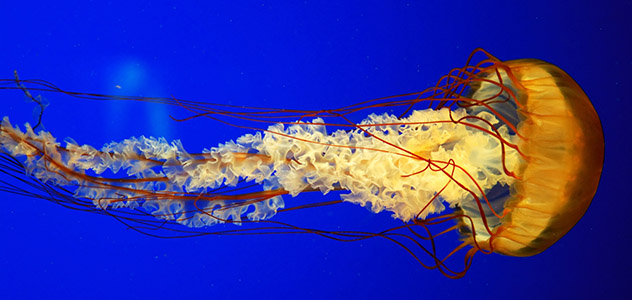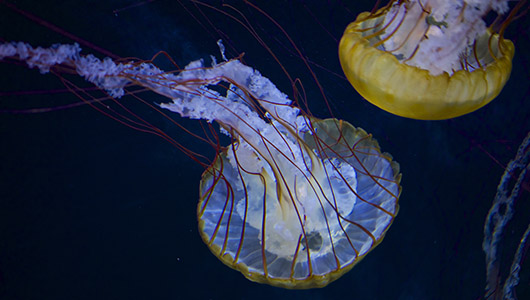Graceful, stunning, and mysteriously alluring—these are just some of the qualities that make the Pacific sea nettle a favorite among Aquarium of the Bay visitors. One look at them and it’s hard not to get lost in the hypnotic lure of these mesmerizing creatures.

Sea nettles (one of over 200 species of jellies worldwide) have four long, dense oral arms that spiral out from the center of their bell, with 24 thin tentacles that surround the outer ring of the bell. Photo courtesy of Aquarium of the Bay
By Mallory Johnson
Published: November, 2014
Graceful, stunning, and mysteriously alluring—these are just some of the qualities that make the Pacific sea nettle a favorite among Aquarium of the Bay visitors. One look at them and it’s hard not to get lost in the hypnotic lure of these mesmerizing creatures. Simply going with the flow as they drift along in a serene manner, these fascinating animals have a calming effect on people watching them.
Jellies have no gills and therefore are not actually fish, despite their popular nickname. Instead, they can be classified as cnidarians (invertebrates with stinging cells), and they are more closely related to sea anemones and corals than they are to fish.
So why are they called jellies? As cnidarians, they have two layers of skin, an ectoderm and an endoderm. Between these layers is a substance called mesoglea, which has the appearance and feel of jelly. The mesoglea provides structural support in lieu of bones or cartilage.
Another organ missing in a jelly’s anatomy is a centralized brain. Instead, they have primitive nerve nets throughout their bodies that control limited motion and other bodily processes. As with other jellies, Pacific sea nettles have little control of their own movement. Their bodies pulsate, but their movement is primarily controlled by Bay and ocean currents.
While there are over 200 species of jellies worldwide, Pacific sea nettles (Chrysaora fuscescens) can be distinguished by a distinctive golden-brown bell with a red tint. They inhabit open waters and are most commonly found along the California and Oregon coasts, but also range into the Gulf of Alaska and as far south as Mexico.
Sea nettles have four long, dense oral arms that spiral out from the center of their bell, with 24 thin tentacles that surround the outer ring of the bell. The oral arms are equipped with stinging cells called nematocysts that instantly sting whatever touches them with a venomous toxin. Their tentacles act like nets, catching tiny drifting prey as they float along.
While toxin from Pacific sea nettles isn’t typically enough to take down larger predators, many smaller animals may fall victim to this deadly entrapment. Among the prey that generally find themselves caught up in these nets are larval fishes, zooplankton and even other jellies. Once caught, prey become immobilized and the oral arms can begin digesting it before it even reaches the jellies mouth.
While these stinging cells can be a nice defense mechanism against some animals, these jellies aren’t completely immune from predation. Larger animals including sea turtles, tuna, sunfish and spiny dogfish frequently dine on this species. However, just because these animals aren’t affected by the jellies’ stings doesn’t mean their entrée of choice is harmless—albeit for an unexpected reason. Many aquatic animals can mistake floating trash like plastic bags for jellyfish, and ingesting such debris can be harmful or fatal.
Jelly species are also being directly affected by climate change. Jellies thrive in warmer waters, so as water temperature rises, so do jelly populations. This can begin to cause an imbalance in the ocean ecosystems. As jelly blooms grow, some adult fish populations become depleted as a result of the plentiful jellies consuming so many fish eggs and larvae.
You can learn even more about Pacific sea nettles—as well as other jelly species such as moon jellies, spotted lagoon jellies, Japanese sea nettles and Cassiopeia jellies—when you visit Aquarium of the Bay. Learn more at www.aquariumofthebay.org.
Mallory Johnson is the Public Relations Coordinator for Aquarium of the Bay, a nonprofit organization dedicated to protecting, restoring and inspiring the conservation of San Francisco Bay and its watershed.

It’s hard not to get lost in the hypnotic lure of the mesmerizing jellies at Aquarium of the Bay. Photo courtesy of Aquarium of the Bay

